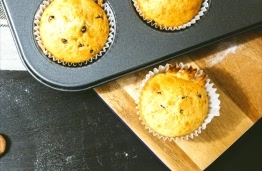Making pastries requires meticulous attention to detail, and every step impacts the perfection of the finished product. You might not realize this, but even seasoned pastry chefs keep these principles in mind every time they bake. Here are 10 things professional pastry chefs do when baking—if you’re just starting out, take note.
Read the recipe carefully before you begin.
Reading and understanding the recipe steps carefully before each attempt is crucial for achieving successful and ideal results.
A thorough understanding of the steps will make the actual process smoother, preventing you from neglecting ingredients or making unnecessary pauses at crucial steps due to flustered preparation.
A smooth process ensures that pastries are completed in an efficient manner and baked in ideal conditions.
Prepare carefully and meticulously.
In French baking and cooking textbooks, you’ll find the term “mise en place,” which refers to the crucial preparation and preparation of ingredients in culinary arts.
The photos of the ingredients in the recipe represent my preparation. During this preparation process, I can double-check the freshness and expiration dates of the ingredients and rehearse the steps.
A bad egg can ruin an entire cake. Each egg should be cracked in a separate container and its quality verified before adding it to the rest of the eggs.
Leaving agents: Yeast, baking powder, and baking soda all have shelf lives. Before using, pay close attention to the expiration date on the packaging or conduct a test to verify the effectiveness of the leavening agent to avoid using an ineffective leavening agent that may have lost its effectiveness due to improper storage and affect the finished product.
Having the ingredients ready will make the process smoother and reduce the risk of forgetting an ingredient and skipping an important step due to lack of experience.
After completing the preparation, it’s recommended to double-check the recipe’s ingredient quantities and types.
Measure, measure, and measure more accurately.
Baking is both an art and a science.
The perfect flavor and balanced texture of a pastry comes from the flavor and quantity of each ingredient in the recipe. If you forget to add salt when cooking, or the flavor isn’t salty enough, you can fix it afterward. Baking is different. Adding too much or too little flour, or even the wrong amount, will determine the texture of the finished pastry and can’t be adjusted or corrected afterward.
The science of baking begins with measurement.
Measurement requires precision. Measuring tools are essential for baking, including a digital scale, standard measuring spoons, and measuring cups. All measurements are based on the metric system.
Measuring cups are used to measure liquid ingredients, such as milk and water. Measuring spoons are used for small portions of ingredients, such as spices and baking leavening agents.
Measure accurately—a gram is a gram, a milliliter is a milliliter, a teaspoon is a teaspoon, no more, no less—and that’s a good start.
Every ingredient and portion size has a reason.
Every ingredient has its own unique characteristics.
Granulated sugar plays a crucial role in pastries, not only providing sweetness but also giving them their perfect color, texture, moistness, and fluffiness.
Each ingredient possesses unique properties that cannot be completely replaced by other similar ingredients.
Simply put, granulated sugar is different from powdered sugar, granulated sugar is different from honey. Butter is different from vegetable oil. Cake flour is different from bread flour. The distinct properties of these ingredients give pastries distinct flavors and appearances.
Increasing sugar, reducing sugar, changing sugar. Changing fats, reducing fats… Substituting or subtracting ingredients also alters the recipe. This changes not only the proportions but also the taste, mouthfeel, and texture balance of the finished product.
Adapting untested recipes increases the potential for variation. For those learning to bake, it can be challenging to review results, identify failures, and make adjustments.
Ingredient Temperature
Paying attention to the temperature of ingredients specified in a recipe is absolutely essential. Many failures are caused by excessive temperature differences between ingredients.
Baking requires four main ingredients: eggs, butter, flour, and sugar. Pay special attention to the temperature and state of the eggs and butter specified in the recipe.
The temperature and state of butter vary depending on the recipe: refrigerated, room temperature, or liquid.
Due to climate influences, if the butter is too hot, it should be refrigerated before use.
For a soft, whipped butter, use a temperature between 16 and 25°C (depending on the seasonal temperature). In summer, use a cooler temperature of around 16 to 18°C.
In winter, the butter should be warmer, around 20 to 25°C.
If the butter is too cold, it will be difficult to whip. If it is not whipped enough, the finished pastry will have a relatively dense texture.
When adding egg liquid to whipped cream, if the temperature difference between the eggs and the butter is too large, the butter will become hard and easily separate.
Preparing the Baking Pans
After deciding on the right baking pan, preparatory work, such as greasing, flouring, and lining with baking paper and silicone baking mats, is essential.
Successful preparation, successful baking, and successful baking are all crucial. Failure to remove the pan due to sticking can be incredibly frustrating.
Preparing the pans includes ensuring they are clean. Before greasing or flouring the pans, carefully inspect them for rust spots or residue from previous bakes, especially around the corners, patterns, and lines. Only then proceed with greasing or flouring.
When using a baking pan with multiple lines and patterns, such as a Guggenheim pan, if you want to achieve a beautifully angled pastry, grease the pan carefully, brushing it back and forth twice before sifting flour over it.
For greasing, softened butter, clarified butter, or margarine can all be used.
For dusting, it’s recommended to sift the flour through a sieve, making sure to pour out any excess. High-gluten flour works best, but other options include cake flour, ground nuts, and bread flour.
After greasing and dusting the pan, refrigerate it before filling it with batter.
If you don’t have the same pan, you can substitute it. For recipes containing leavening agents, fill the pan no more than 70% full. For recipes without leavening agents, fill it no more than 80% full.
Overfilling the pan with batter will cause the batter to rise during baking, preventing the upper batter from settling and forming. This will increase the baking time, resulting in a thick, dry, and overbaked cake. The finished product will also suffer from a poor appearance.
Preparing the pan beforehand not only helps the cake release smoothly but also makes cleaning easier. The “protective film” formed by the butter and flour also extends the life of the pan.
Preheat the Oven
Baking is absolutely temperature-dependent.
Preheat the oven in advance. For simple homemade cakes, it’s customary to preheat the oven as soon as you begin preparing the ingredients.
The length of preheating time varies from oven to oven. The oven should be preheated until it reaches the desired baking temperature. The oven should have reached the specified baking temperature before the cake is baked. Only at the correct temperature can the cake rise, set, brown, and be cooked through.
If you’re unfamiliar with your oven’s performance or notice temperature instability, it’s recommended to purchase an oven thermometer.
Sift Dry Flour Ingredients
Dry flour ingredients, such as flour, salt, baking powder, baking soda, cornstarch, cocoa powder, matcha powder, etc., should be sifted before use. This is especially important for cake flour, which tends to clump easily, or cocoa powder and matcha powder, which absorb moisture easily. This will prevent lumps and clumps in the finished pastry.
Sifting dry flour removes impurities and coarse particles, making mixing easier. The sifting process traps air in the flour, thereby increasing the fluffiness of the finished pastry.
If a recipe uses leavening agents, such as baking powder and baking soda, they should be added to the flour first, mixed thoroughly, and then sifted. This will ensure a fluffy, uniformly sized air pore texture in the baked cake.
When choosing a sieve, the pores should not be too large, otherwise the purpose of sifting is lost.
Avoid Overworking
Cream frosting, meringue, pastry batter, tart dough, cookie dough…different pastries require different preparation methods. The most important thing is to use the correct method to achieve the ideal batter and dough.
When making pastries, special attention should be paid to the mixing of the dry and wet ingredients. For example, when making batter, stop mixing when the batter is smooth and uniform.
Excessive, forceful, rapid, or incorrect stirring, or using the wrong tools, can cause the flour to develop gluten or the air in the meringue to deflate (deflate), resulting in a poorly finished product.
When making tart crust, avoid repeated kneading, pulling, and unnecessary folding to prevent the ideal texture.
Keep an Eye on the Oven
When baking pastries, you should set a timer and keep an eye on the oven from the moment they enter the oven.
My personal habit is that if a recipe calls for a 60-minute bake, I set the timer for 50 minutes. At 30 minutes (halfway through the baking time), I observe the pastry’s shape, browning, and puffiness, and consider whether to cover it with aluminum foil or turn the baking pan over.
Use this 10-minute difference to determine whether to extend or shorten the baking time or increase or decrease the baking temperature.
It’s recommended not to open the oven door until halfway through the baking time to prevent cold air from entering and affecting the oven’s internal temperature. Especially during the rising phase of pastries, if the temperature is too low, the cake won’t rise tall and puff up.
Each oven has different functions, performance, heat circulation design, and hotspot locations. Generally, the temperature is lower near the door. Only by monitoring the oven can you achieve evenly heated and uniformly colored finished products.
Regularly monitoring your oven will help you better understand it, and this familiarity will greatly benefit your future operation.


Leave a Reply